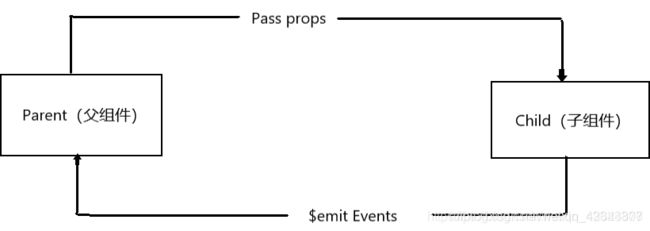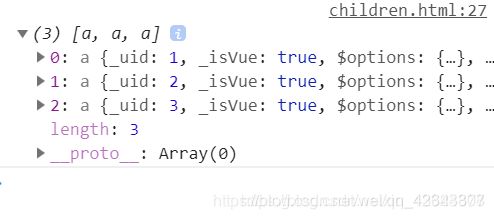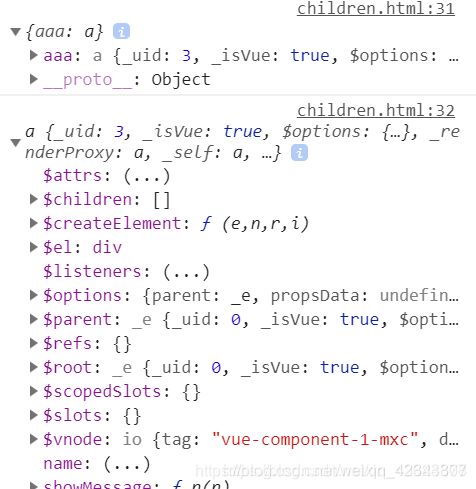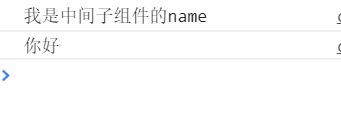vue父子组件间引用之$parent、$children $refs
vue父子组件间引用之 p a r e n t 、 parent、 parent、children
这篇文章主要介绍了vue父子组件间引用之 p a r e n t 、 parent、 parent、children的相关知识,本文给大家介绍的非常详细,对大家的学习或工作具有一定的参考借鉴价值,需要的朋友可以参考下
vue中提到【父子组件】,则一定会想到我们常用的父子组件通信:props+ o n ( ) 、 on()、 on()、emit() ,如图:

也就是说,虽然在一般情况下,子组件是不能引用父组件或者Vue实例的数据,但是对于在开发中出现的“数据需要在组件中来回传递”,我们最简单的解决办法就是通过props(和v-on)将数据从父组件传到子组件,再用$emit将数据从子组件传到父组件,以此循环引用。
但是在另一些场景下,我们可能想要比如(在父组件中)拿到子组件对象,然后直接操作其中数据,去实现一些功能,比如方法的调用。
有时候我们需要父组件直接访问子组件、子组件直接访问父组件,或者子组件访问根组件:
- 父组件访问子组件:使用 c h i l d r e n 或 children或 children或refs reference
- 子组件访问父组件:使用$parent
父子组件的访问方式之:$children
children很特别,查阅资料可以发现:this.$children是一个数组类型,它包含了所有子组件对象:
<body>
<div id="app">
<mxc>mxc>
<mxc>mxc>
<mxc>mxc>
<button @click="btnClick">颤抖吧button>
div>
<template id="mxc">
<div>我是子组件啊div>
template>
<script>
const app=new Vue({
el:'#app',
data:{
message:'你好'
},
methods:{
btnClick(){
console.log(this.$children)
}
},
components:{
mxc:{
template:'#mxc',
methods:{
showMessage(){
console.log('mxcnb')
}
}
}
}
})
script>
body>
点击(父组件)按钮之后:

我们还可以通过循环拿到所有子组件数据
<body>
<div id="app">
<mxc>mxc>
<mxc>mxc>
<mxc>mxc>
<button @click="btnClick">颤抖吧button>
div>
<template id="mxc">
<div>我是子组件啊div>
template>
<script>
const app=new Vue({
el:'#app',
data:{
message:'你好'
},
methods:{
btnClick(){
console.log(this.$children)
for(let c of this.$children){
console.log(c.name)
}
}
},
components:{
mxc:{
template:'#mxc',
data(){
return{
name:'我是子组件的name'
}
},
methods:{
showMessage(){
console.log('mxcnb')
}
}
}
}
})
script>
body>
点击(父组件)按钮之后:

因为是数组,所以我们可以通过比如:this.$children[2]来拿到第三个子组件的数据。
但是这么做有一个问题:比如开发时突然在这三个子组件中又插入了一个子组件(可能相同,也可能不同),这时候【2】就不再是我们需要的了。。。
所以我们可以用vue-DOM之光:$refs :
<body>
<div id="app">
<mxc>mxc>
<mxc>mxc>
<mxc ref="aaa">mxc>
<button @click="btnClick">颤抖吧button>
div>
<template id="mxc">
<div>我是子组件啊div>
template>
<script>
const app=new Vue({
el:'#app',
data:{
message:'你好'
},
methods:{
btnClick(){
console.log(this.$refs)
console.log(this.$refs.aaa)
}
},
components:{
mxc:{
template:'#mxc',
data(){
return{
name:'我是子组件的name'
}
},
methods:{
showMessage(){
console.log('mxcnb')
}
}
}
}
})
script>
body>
为什么叫“DOM之光”呢?因为它和原生JS中的document.querySelector(‘xxx’)功能一样,它可以在vue中获取元素/匹配组件
子访问父:$parent
<body>
<div id="app">
<mxc>mxc>
div>
<template id="mxc">
<div>我是子组件啊div>
<button @click="btnClick">更加颤抖的childbutton>
template>
<script>
const app=new Vue({
el:'#app',
data:{
message:'你好'
},
components:{
mxc:{
template:'#mxc',
methods:{
btnClick(){
console.log(this.$parent)
}
}
}
}
})
script>
body>
如法炮制:

图中el属性在有些浏览器(或添加了vue插件)会显示未Vue?
因为当前子组件的父组件就是vue实例啊!
(但是在实际中$parent用的非常少——考虑到耦合度的原因)
子组件访问根组件:$root
<body>
<div id="app">
<mxc>mxc>
div>
<template id="mxc">
<div>
<div>我是mxc组件div>
<cdn>cdn>
div>
template>
<template id="mxca">
<div>
<div>我是子子组件啊div>
<button @click="btnClick">巨颤祖childbutton>
div>
template>
<script>
const app=new Vue({
el:'#app',
data:{
message:'你好'
},
components:{
mxc:{
template:'#mxc',
data(){
return{
name:'我是中间子组件的name'
}
},
components:{
cdn:{
template:'#mxca',
methods:{
btnClick(){
console.log(this.$parent.name)
console.log(this.$root.message)
}
}
}
}
}
}
})
script>
body>

